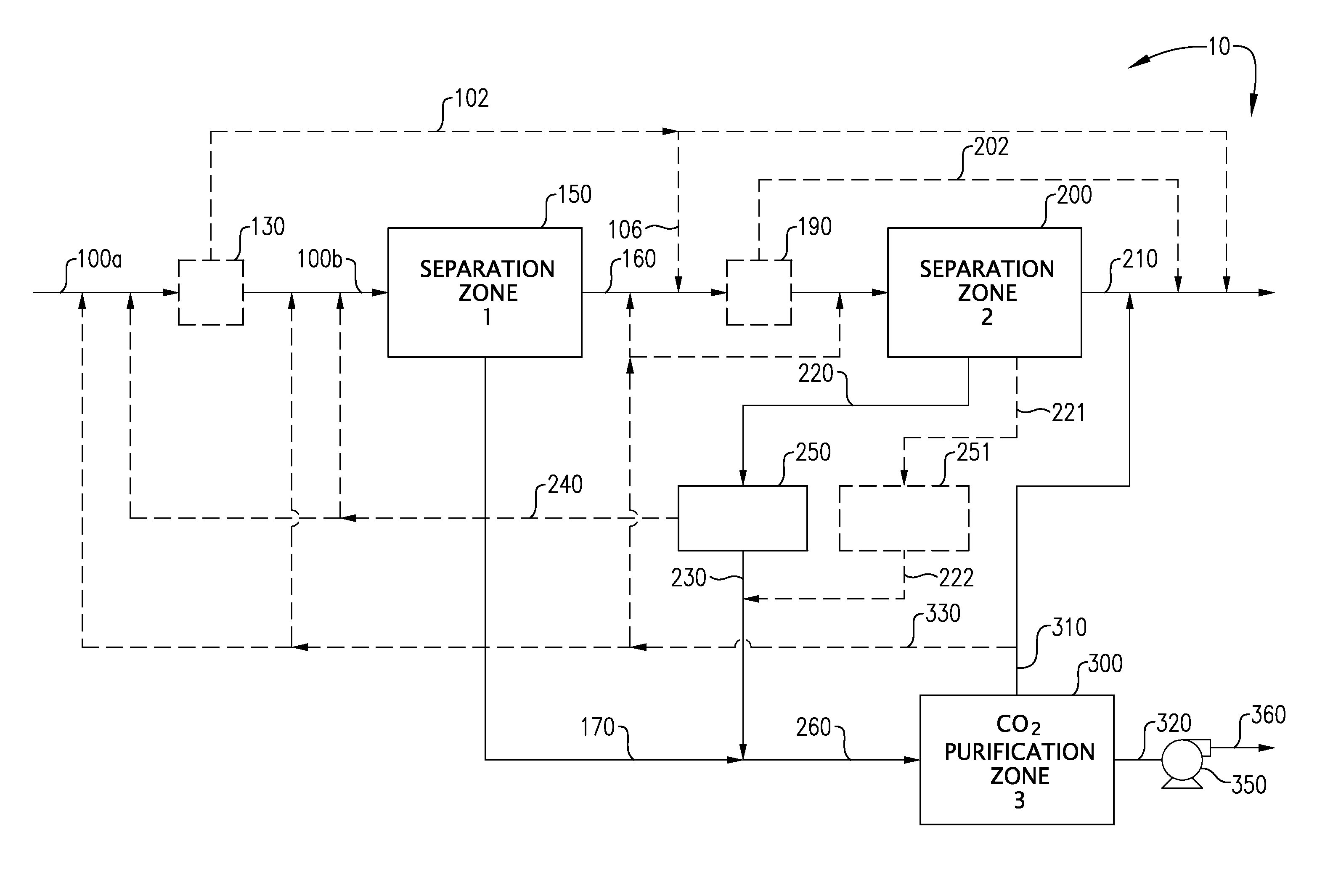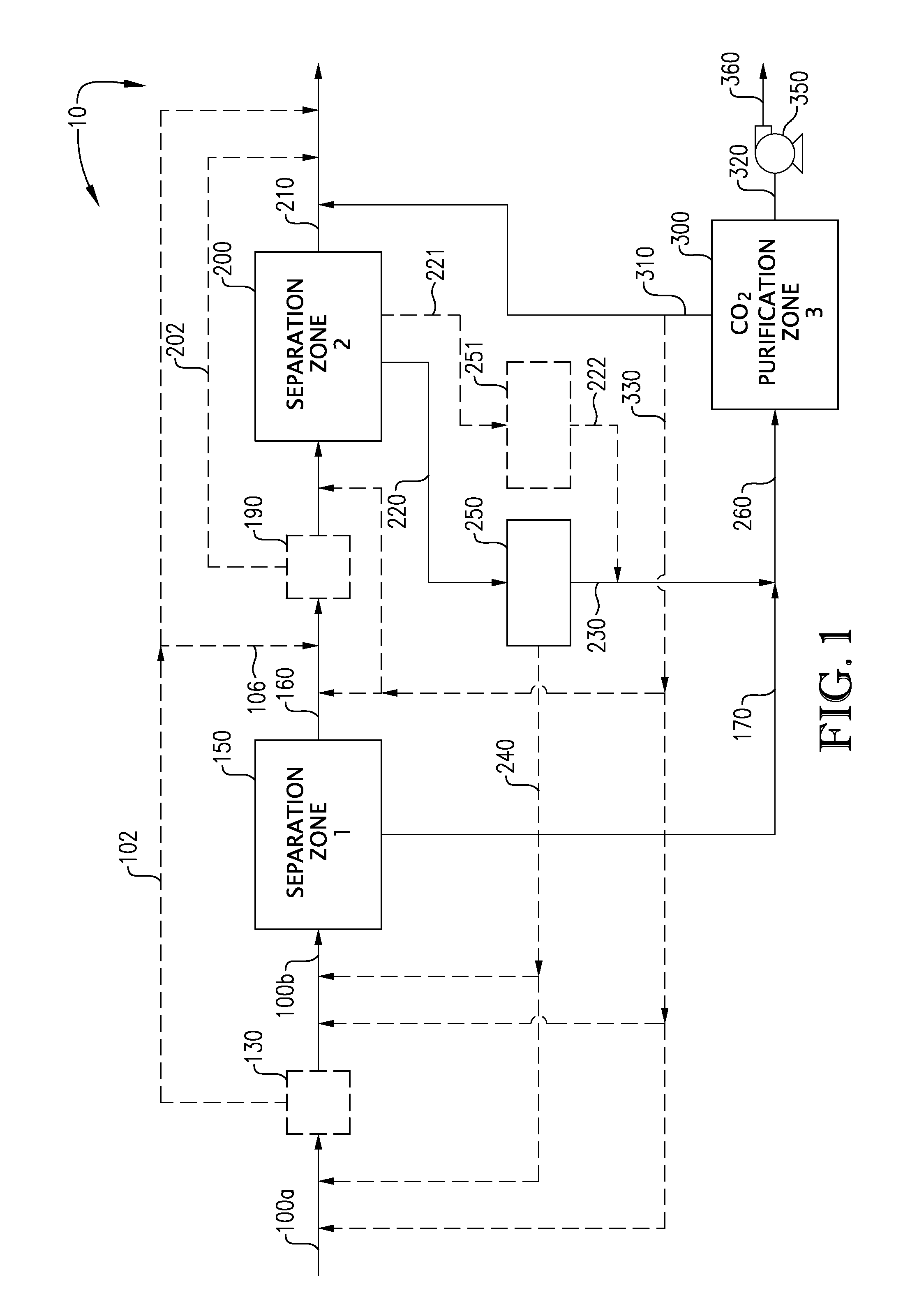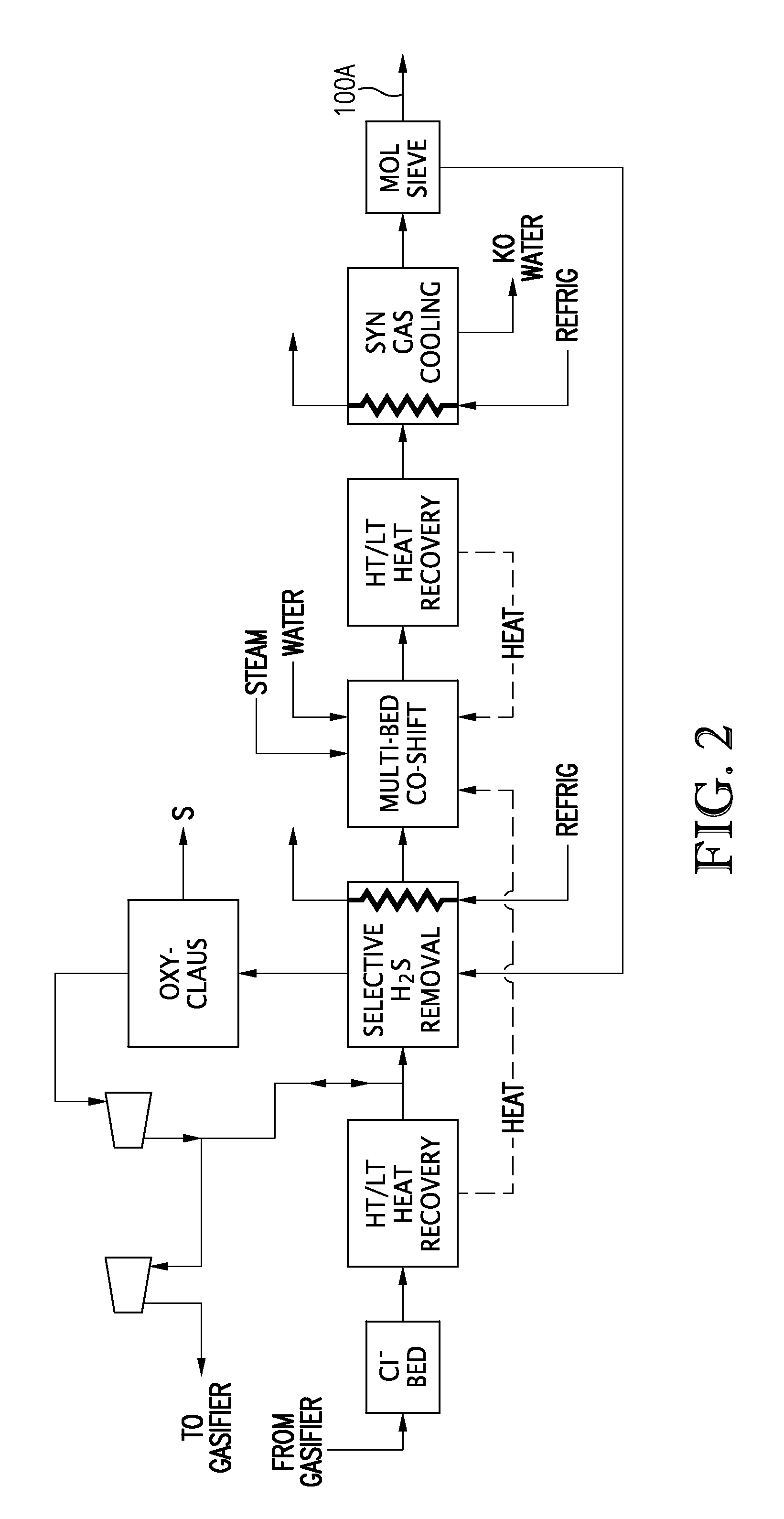Carbon dioxide capture and liquefaction
a carbon dioxide and liquefaction technology, applied in the field of carbon dioxide capture and liquefaction, can solve the problems of little incentive to develop the technology necessary to carry out this sequestration step, low economic advantage, and soon economic disruption to the status quo, so as to minimize energy consumption and increase economic advantage
- Summary
- Abstract
- Description
- Claims
- Application Information
AI Technical Summary
Benefits of technology
Problems solved by technology
Method used
Image
Examples
example 1
Simulation of a CO2 Recovery Facility Utilizing an Absorption Stage
[0116]The system depicted in FIGS. 4a and 4b was modeled using the PD-Plus Chemical Process Simulator (available from Deerhaven Technical Software, Moultonborough, N.H.). Table 5, below, presents the Heat & Material Balance (HMB) obtained from the simulation of the CO2 recovery facility that utilizes an absorption stage in the second separation zone.
[0117]
TABLE 5Heat and Material Balance for CO2 Recovery Facility Utilizing Absorption Stage (FIGS. 4a and 4b)Stream Number123A34Temperature (° F.)45.72.6−2−2.1−19.5Pressure (psia)659.2651.2643.2643.2635.2Fraction Liquid00000.0536LBMOL / HRHYDROGEN68,164.3068,164.3068,164.3069,155.8068,164.30CARBON MONOXIDE1,031.101,031.101,031.101,064.001,031.10METHANE500.70500.70500.70528.70500.70CARBON DIOXIDE62,901.6062,901.6062,901.6064,259.1062,901.60NITROGEN4,683.904,683.904,683.904,865.604,683.90TOTAL137,281.60137,281.60137,281.60139,873.20137,281.60Stream Number56789Temperature (° F...
example 2
Simulation of a CO2 Recovery Facility Utilizing an Adsorption Stage
[0118]The system depicted in FIGS. 5a and 5b was modeled using the PD-Plus Chemical Process Simulator (available from Deerhaven Technical Software, Moultonborough, N.H.). Table 6, below, presents the Heat & Material Balance (HMB) obtained from the simulation of the CO2 recovery facility that utilizes an adsorption stage in the second separation zone.
[0119]
TABLE 6Heat and Material Balance for CO2 Recovery Facility Utilizing Adsorption Stage (FIGS. 5a and 5b)Stream Number12345Temperature (° F.)45.73.9−2−17.8−38Pressure (psia)659.2651.2643.2635.2627.2Liquid Fraction0000.03120.2184HYDROGEN68,164.3068,164.3068,164.3068,164.3068,164.30CARBON MONOXIDE1,031.101,031.101,031.101,031.101,031.10METHANE500.70500.70500.70500.70500.70CARBON DIOXIDE62,901.6062,901.6062,901.6062,901.6062,901.60NITROGEN4,683.904,683.904,683.904,683.904,683.90TOTAL137,281.60137,281.60137,281.60137,281.60137,281.60Stream Number678910Temperature (° F.)−3...
example 3
Simulation of a CO2 Recovery Facility Utilizing a Deliberate Freezing Stage
[0120]The system depicted in FIGS. 6a and 6b was modeled using the PD-Plus Chemical Process Simulator (available from Deerhaven Technical Software, Moultonborough, N.H.). Table 7, below, presents the Heat & Material Balance (HMB) obtained from the simulation of the CO2 recovery facility that utilizes a deliberate freezing stage in the second separation zone.
[0121]
TABLE 7Heat and Material Balance for CO2 Recovery Facility Utilizing Freezing Stage (FIGS. 6a and 6b)Stream Number12345Temperature (° F.)45.70.1−2−18.6−38Pressure (psia)659.2651.2643.2635.2627.2Liquid Fraction0000.04240.2184HYDROGEN68,164.3068,164.3068,164.3068,164.3068,164.30CARBON MONOXIDE1,031.101,031.101,031.101,031.101,031.10METHANE500.70500.70500.70500.70500.70CARBON DIOXIDE62,901.6062,901.6062,901.6062,901.6062,901.60NITROGEN4,683.904,683.904,683.904,683.904,683.90TOTAL137,281.60137,281.60137,281.60137,281.60137,281.60Stream Number678910Temper...
PUM
| Property | Measurement | Unit |
|---|---|---|
| pressure | aaaaa | aaaaa |
| pressure | aaaaa | aaaaa |
| boiling point | aaaaa | aaaaa |
Abstract
Description
Claims
Application Information
 Login to View More
Login to View More - R&D
- Intellectual Property
- Life Sciences
- Materials
- Tech Scout
- Unparalleled Data Quality
- Higher Quality Content
- 60% Fewer Hallucinations
Browse by: Latest US Patents, China's latest patents, Technical Efficacy Thesaurus, Application Domain, Technology Topic, Popular Technical Reports.
© 2025 PatSnap. All rights reserved.Legal|Privacy policy|Modern Slavery Act Transparency Statement|Sitemap|About US| Contact US: help@patsnap.com



